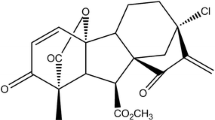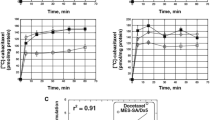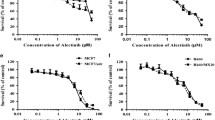Abstract
Modulators for the reversal of multidrug resistance such as R-verapamil and B8509-035, a dihydropyridine, effectively overcome multidrug resistance in vitro and are currently undergoing clinical trial. One problem with their use is the application protocol; the question as to whether they should be given by continuous administration or in sequential doses in combination with the cytotoxic drugs has to be addressed. Therefore, we examined the influence of the exposure time and the sequence of modulator administration on the active transport of the fluorescent dye rhodamine 123 (R123), a substrate for the P-glycoprotein, in the resistant lymphoblastid cell line VCR1000 and the parental nonresistant cell line CCRFCEM. Our results demonstrate the importance of coadministration of R-verapamil and the cytotoxic agent for the modulation of multidrug resistance, whereas the exposure sequence does not seem to be such an essential parameter in the case of B8509-035. This observation should be considered for the further design of clinical studies.
Similar content being viewed by others
References
Bissett D, Kerr DJ, Cassidy J, Meredith P, Traugott U, Kaye SB (1991) Phase I and pharmacokinetic study ofD-verapamil and doxorubicin. Br J Cancer 64: 1168
Cass CE, Janowska-Wieczorek A, Lynch M, Sheinin H, Hindenburg AA, Beck WT (1989) Effect of duration of exposure to verapamil on vincristine activity against multidrug-resistant human leukemic cell lines. Cancer Res 49: 5798
Cairo MS, Siegel SS, Sender L (1989) Clinical trial of continuous infusion verapamil, bolus vinblastine, and continuous infusion VP16 in drug resistant pediatric tumors. Cancer Res 49: 1063
Cordon-Cardo C, O'Brien JP, Boccia J, Casalis D, Bertino JR, Melamed MR (1990) Expression of the multidrug resistance gene product (P-glycoprotein) in human normal and tumor tissues. J Histochem Cytochem 38: 1277
Dalton WS, Grogan TM, Meltzer PS, Scheper RJ, Durie BGM, Taylor CW, Miller TP, Salmon SE (1989) Drug resistance in multiple myeloma and non-Hodgkin's lymphoma: detection of P-glycoprotein and potential circumvention by addition of verapamil to chemotherapy. J Clin Oncol 8: 415
Demicheli R, Jirillo A, Bonciarelli G, Lonardi F, Balli M, Bandello A (1989) 4′-Epidoxorubicin plus verapamil in anthracycline-refractory cancer patients. Tumori75: 245
Ferry DR, Russell MA, Cullen MH (1992) P-glycoprotein possesses a 1,4-dihydropyridine-selective drug acceptor site which is alloserically coupled to a vinca-alkaloid-selective binding site. Biochem Biophys Res Commun 188: 440
Friche E, Skovsgaard T, Nissen NI (1987) Effect of verapamil on daunorubicin accumulation in Ehrlich ascites tumor cells. Cancer Chemother Pharmacol 19: 35
Gekeler V, Frese G, Diddens H, Probst H (1988) Expression of a P-glycoprotein gene is inducible in a multidrug-resistant human leukemia cell line. Biochem Biophys Res Commun 155: 754
Gietzen K, Abdallah F, Bai G (1990) Selective inhibition of proliferation by a novel dihydropyridine derivative with anti-calmodulin activity in the mamma tumor cell line ZR-75-1.Med Sci Res 18: 627
Goldstein LJ, Galski H, Fojo A, et al (1989) Expression of a multidrug resistance gene in human cancers. J Natl Cancer Inst 81: 116
Gottesman MM, Pastan I (1988) The multidrug transporter, a double-edged sword. J Biol Chem 263: 12163
Gruber A, Peterson C, Reizenstein P (1988)D-Verapamil andL-verapamil are equally effective in increasing vincristine accumulation in leukemic cells in vitro. Int J Cancer 41: 224
Häußermann K, Benz B, Gekeler V, Schumacher K, Eichelbaum M (1991) Effects of verapamil enantiomers and major metabolites on the cytotoxicity of vincristine and daunomycin in human lymphoma cell lines. Eur J Clin Pharmacol 40: 53
Hamada H, Tsuruo T (1986) Functional role for the 170-to 180-kDa glycoprotein specific to drug-resistant tumor cells as revealed by monoclonal antibodies. Proc Natl Acad Sci USA 83:7785
Hofmann J, Ueberall F, Egle A, Grunicke H (1991) B-859-35, a new drug with anti-tumor activity, reverses multi-drug resistance. Int J Cancer 47: 870
Hofmann J, Wolf A, Spitaler M, Böck G, Drach J, Ludescher C, Grunicke H (1992) Reversal of multidrug resistance by B859-35, a metabolite of B859-35, niguldipine, verapamil and nitrendipine. J Cancer Res Clin Oncol 118: 361
Kartner N, Ling V (1989) Multidrug resistance in cancer. Sci Am 260: 44
Kamiwatari M, Gagata U, Kikuche H, Yoshimura A, Sumizawa T, Shudo N, Sakoda R, Seto K, Akiyama S (1989) Correlation between reversing of multidrug resistance and inhibiting of3H-azidopine photolabeling of P-glycoprotein by newly synthesized dihydropyridine analogues in a human cell line. Cancer Res 49: 3190
Kessel D (1986) Interactions among membrane transport systems: anthracyclines, colcium antagonists and anti-estrogens. Biochem Pharmacol 35: 2825
Kessel D, Beck WT, Kukuruga D, Schulz V (1991) Characterization of multidrug resistance by fluorescent dyes. Cancer Res 51: 4665
Kuwazuru Y, Yoshimura A, Hanada S, Utsunomiya A, Makino T, Ishibashi K, Kodama M, Iwahashi M, Arima T, Akiyama S (1990) Expression of the multidrug transporter, P-glycoprotein, in acute leukemia cells and correlation to clinical drug resistance. Cancer 66: 868
Lampidis TJ, Castello C, Del Gilio A, Pressman BC, Viallet P, Trevorrow KW, Valet GK, Tapiero H, Savaraj N (1989) Relevance of the chemical charges of rhodamine dyes to multiple drug resistance. Biochem Pharmacol 38: 4267
Ludescher C, Gattringer C, Drach J, Hofmann J, Grunicke H (1991) Rapid functional assay for the detection of multidrug-resistant cells using the fluorescent dye rhodamine 123. Blood 78: 1385
Mosmann T (1983) Rapid colorimetric assay for cellular growth and survival: application to proliferation and cytotoxicity assays. J Immunol Methods 65: 55
Roller E, Benz B, Eichelbaum M, Gekeler V, Häußermann K, Klumpp B, Schumacher K (1992) Reversal of multidrug resistance with a new calcium/calmodulin antagonist. In: Hiddemann W, Büchner T, Plunkett B, Keating M, Wörmann B, Andreeff M (eds) Acute leukemias-pharmacokinetics. Springer, Berlin Heidelberg New York, p 40
Safa AR, Glover CJ, Meyers MB, Biedler JL, Felsted RL (1987) Identification of the multidrug resistance-related membrane glycoprotein as an acceptor for calcium channel blockers. J Biol Chem 262: 7884
Sasaki DT, Dumas SE, Engleman EG (1987) Discrimination of viable and non-viable cells using propidium iodide in two-color immunofluorescence. Cytometry 8: 413
Tsuruo T, Iida H, Nojiri M, Tsukagoshi S, Sakurai Y (1983) Circumvention of vincristine and Adriamycin resistance in vitro and in vivo by calcium influx blockers. Cancer Res 43: 2905
Volm M, Bak M, Efferth T, Mattern J (1989) Induced multidrug resistance in murine leukemia L1210 and associated changes in a surface-membrane glycoprotein. J Cancer Res Clin Oncol 115: 17
Yusa K, Tsuruo T (1989) Reversal of multidrug resistance by verapamil: direct binding of verapamil to P-glycoprotein on specific sites and transport of verapamil outward across the plasma membrane of K562/ADM cells. Cancer Res 49:5002
Author information
Authors and Affiliations
Additional information
This research was supported by the Robert-Bosch-Foundation, Stuttgart, Germany
Rights and permissions
About this article
Cite this article
Roller, E., Klumpp, B., Krause, J. et al. Influence of sequential exposure to R-verapamil or B8509-035 on rhodamine 123 accumulation in human lymphoblastoid cell lines. Cancer Chemother. Pharmacol. 32, 151–155 (1993). https://doi.org/10.1007/BF00685619
Received:
Accepted:
Issue Date:
DOI: https://doi.org/10.1007/BF00685619




